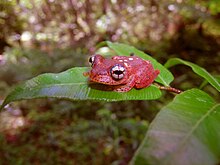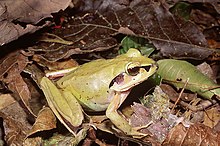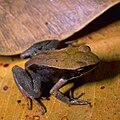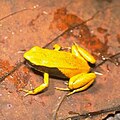Madagascar frogs
| Madagascar frogs | ||||||||||||
|---|---|---|---|---|---|---|---|---|---|---|---|---|

Golden frog ( Mantella aurantiaca ) |
||||||||||||
| Systematics | ||||||||||||
|
||||||||||||
| Scientific name | ||||||||||||
| Mantellidae | ||||||||||||
| Laurent , 1946 |
Madagascar frogs (Mantellidae) form a family of frogs . The best-known representative is the uniformly orange colored gold frog , after which the entire family or at least the genus Mantella is sometimes named. Madagascar frogs are endemic to Madagascar and the small northern neighboring island of Mayotte in the Indian Ocean and represent the largest part of the amphibian fauna of Madagascar - the other species on the island mainly belong to the narrow-mouth frogs (Microhylidae) and the reed frogs (Hyperoliidae).
features
They are mostly small to medium-sized frogs with a head-trunk length of 1.5 to 5 centimeters. Some species become significantly larger, Mantidactylus guttulatus, for example, reaches a head-trunk length of 10 to 12 centimeters.
The lively and sometimes extremely colorful animals produce effective skin toxins , so-called lipophilic alkaloids . This evolutionary development, like the anatomical blueprint, the ecology and the intense coloration, can be viewed as a biological convergence to the poison dart frogs of Latin America.
Way of life
The species of the genus Mantella usually live diurnally , predominantly on the ground in moist to swampy mountain forests, but also near the coast. The other members of the family look more like tree frogs and, like them, climb in the vegetation with the help of adhesive discs on the limbs.
Madagascar frogs , at least of the genus Mantella , are one of the few frogs that carry out internal fertilization (compare also: tail frogs ). This was first noticed when solitary females were observed laying down their subsequently developing spawn . The males release their sperm at the amplexus on the back of the females, where the seminal fluid runs down to the cloaca and is absorbed there. The eggs are deposited on land on the ground or on plants as small clutches near water, so that the hatching tadpoles can meander to reach the water, in which they continue their development up to metamorphosis . In some species, however, there is also direct development within the eggs. This is where ready-made young frogs hatch from the eggs.
Taxonomy
After the subfamily Mantellinae were previously assigned to the real frogs (Ranidae) and other representatives to the rowing frogs (Rhacophoridae), a separate family Mantellidae is now formed, in which three subfamilies, twelve genera and over 230 species are differentiated according to the systematics presented here . Numerous new species are also currently being discovered and described.
As of August 21, 2019
Subfamily Boophinae Vences & Glaw , 2001
- Genus Boophis Tschudi, 1838
Subfamily Laliostominae Vences & Glaw, 2001
- Genus Aglyptodactylus Boulenger, 1919
- Genus Laliostoma Glaw, Vences & Böhme, 1998
Subfamily Mantellinae Laurent, 1946
- Genus Blommersia Dubois, 1992
- Genus Boehmantis Glaw & Vences, 2006
- Genus Gephyromantis Methuen, 1920
- Genus Guibemantis Dubois, 1992
- Genus Mantella Boulenger, 1882 - Madagascar colored frogs
- Genus Mantidactylus Boulenger, 1895
- Genus Spinomantis Dubois, 1992
- Genus Tsingymantis Glaw, Hoegg & Vences, 2006
- Genus Wakea Glaw & Vences, 2006
Danger
Various species of Madagascar frogs are threatened by progressive habitat destruction (deforestation, draining of wetlands), especially since they often only colonize very small areas. Despite strict protection regulations - in the Washington Convention for the Protection of Species, for example, all species of the genus Mantella are listed in Appendix II - some species are considered to be popular terrarium pets.
Individual evidence
- ↑ Laurie J. Vitt & Janalee P. Caldwell: Herpetology, Fourth Edition: An Introductory Biology of Amphibians and Reptiles. 2013, Academic Press, ISBN 9780123869197 , pp. 503-504.
- ↑ Darrel R. Frost: Mantellidae Laurent, 1846 . In: Amphibian Species of the World: an Online Reference . Version 6.0. American Museum of Natural History, New York 1998–2019. Retrieved August 21, 2019.
- ↑ DR Vieites, KC Wollenberg, F. Andreone, J. Köhler, F. Glaw & M. Vences: Vast underestimation of Madagascar's biodiversity evidenced by an integrative amphibian inventory. ( English-language summary of a publication regarding a current inventory of the amphibian fauna of Madagascar, 2009 )
- ↑ Press release at idw-online from May 4, 2009 on the above inventory
- ↑ Report at Spiegel-online from May 5, 2009 on the above inventory (with some photos of newly discovered species - partly also from the Microhylidae family)
- ↑ Mantella at Wisia.de
literature
- Olga Jovanovic: Natural history of Malagasy poison frogs: experimental analysis of aposematism, morphology of tadpoles, and longevity. Braunschweig 2009, DNB 999986767 (Dissertation TU Braunschweig, Faculty of Life Sciences, 2009, 105 pages, (English)).
Web links
- List of species of the family Mantellidae at Amphibiaweb
- Darrel R. Frost: Mantellidae Laurent 1946 . In: Amphibian Species of the World: an Online Reference . Version 6.0. American Museum of Natural History, New York 1998–2019. Retrieved August 21, 2019
- Website Miguel Vences , specialist in the amphibious fauna of Madagascar




















